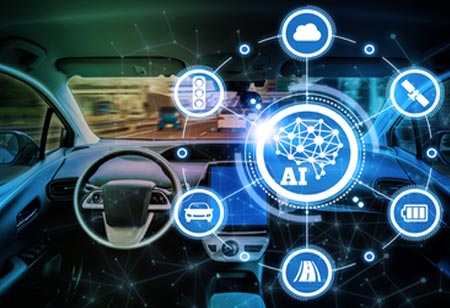THANK YOU FOR SUBSCRIBING
THANK YOU FOR SUBSCRIBING
Be first to read the latest tech news, Industry Leader's Insights, and CIO interviews of medium and large enterprises exclusively from Auto Tech Outlook

By
Auto Tech Outlook | Monday, June 07, 2021
Stay ahead of the industry with exclusive feature stories on the top companies, expert insights and the latest news delivered straight to your inbox. Subscribe today.
The importance of visual sensors such as high-resolution cameras, LiDAR, and radar to provide precise localization and contextual information in internal AI systems is increasing, which is boosting computer hardware growth.
FREMONT, CA: Manufacturing robots are nothing new these days, but AI applications in the automotive industry are still in their infancy. The high cost is one of the primary reasons why this powerful technology is currently only available to industry leaders. High competition in the automotive industry, on the other hand, is pressuring manufacturers to invest in better equipment and more intelligent technologies to increase the quality of new releases without compromising time.
AI Use Cases in Automotive Vehicle
GPUs (Graphics Processing Unit) with Artificial Intelligence (AI) for Computer Hardware
With dedicated AI-enabled GPUs, AI hardware adoption would explode, enabling self-driving technology and upgrading AI algorithms. The importance of visual sensors such as high-resolution cameras, LiDAR, and radar to provide precise localization and contextual information in internal AI systems is increasing, which is boosting computer hardware growth. Furthermore, the advancement of commonly used AI processors and computer software would allow businesses to design and deploy advanced self-contained solutions.
AI Applies to Telematics Data
AI and Machine Learning (ML) open up new ways to read and interpret data from a wide range of sources. The remote control uses these types of technology to provide the next stage of business and user communication tools. Remote AI is built on the remote connected car platform, which collects data from hundreds of thousands of connected drivers. Ride, telemetry, RPM engine, acceleration and deceleration, collisions, and other data collected on all vehicles can be used to make people's lives simpler, including consumers and industry employees. That is why, based on incoming telematics data, businesses use AI and ML to build custom recommendations. AI data processing helps attract insurance providers, parking and car-sharing facilities, and other data-driven businesses to the ecosystem.
Monitoring of Driving and User Conduct
In private vehicles, AI performance is not constrained by strict criteria such as safety. Within the vehicle, AI can be used for more power and entertainment. During the journey, AI assists in providing personalized entertainment. AI will speculate and have expectations based on user experience based on data collected over time. This may include the following:
Seat position adjustment
Adjusting the screen
Controls air input
Songs to be played
AI encourages advanced driving so that people can navigate with ease. Governments have also jumped into the fray, encouraging investors to develop AI-powered non-motorized vehicles.
See Also: Top Automotive Companies
 Copyright © 2025 AutoTech Outlook. All Rights Reserved | Privacy Policy | Subscribe | Sitemap | About us | Feedback Policy | Editorial Policy
Copyright © 2025 AutoTech Outlook. All Rights Reserved | Privacy Policy | Subscribe | Sitemap | About us | Feedback Policy | Editorial Policy 
However, if you would like to share the information in this article, you may use the link below:
https://www.autotechoutlookapac.com/news/how-is-ai-powering-the-automotive-industry-nwid-666.html




